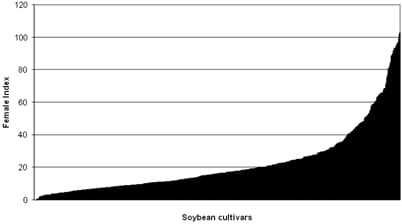Nathan Kleczewski, Extension Specialist – Plant Pathology; nkleczew@udel.edu
Soybean Nematodes
Damage from Root knot nematode (RKN) (Figure 1) and Soybean cyst nematode (SCN) (Figure 2) are fairly evident in some fields right now.
Figure 1. Galls from Root Knot Nematode on a soybean root. Galls are irregular and range in size.
Figure 2. Small, lemon shaped cysts indicative of SCN. These are much smaller than nodules. Nodules will have a pink to orange center when split open.
Galls from RKN are easily observed by removing plants from the soil, and often result in large almost tumor-like growths on roots. To observe SCN, the roots and soil must be removed carefully with a shovel, and the soil gently separated from the root. SCN females or cysts are small, lemon shaped, and white to yellow. A hand lens may be required to observe SCN cysts on roots. Nodules, which form as a part of the soybean plant’s beneficial relationship with nitrogen-fixing bacteria, can be distinguished from SCN cysts by size; nodules are larger than cysts. When split, nodules have an orange to pink center, which differentiates them from small galls caused by RKN. Areas of a field severely affected by nematodes will have chlorotic or stunted plants, often in irregularly shaped patches. Symptoms may occur earlier or more severely in dry areas of fields. You also can have significant nematode pressure without symptom development. In these cases, you will not notice the problem until harvest when you look at your yield monitors.
There are several RKN resistant cultivars currently on the market. If you have RKN in your soybeans, consider using a RKN resistant cultivar the next time you grow beans in that field. Resistant beans should also be used when planting into fields with a history of SCN; however, due to limited sources of SCN resistance available in our area, you should avoid planting continuous beans and rotate to a crop such as corn for at least one season in between soybean plantings. If you have significant SCN issues, rotating out of soybeans for two or more years may be needed to sufficiently reduce the nematode population.
As a side note, remember that a “race” of a nematode actually means that that type of nematode is the most commonly occurring in your field or region. Cultivars that are screened by industry originate from different locations, and therefore the genetic makeup of the screening population differs. This, and the complexity of SCN resistance, means that resistance (reduction of SCN reproduction) between cultivars with the same type of resistance can differ significantly. Figure 3 illustrates this point.
Figure 3. The female index of 622 cultivars labeled as resistant to race 3 SCN treated with 1000 eggs of a Race 3,6 population. The female index indicates the amount of reproduction, and therefore the amount of likely damage due to SCN. From Niblack et al 2009. A Standard Greenhouse Method for Assessing Soybean Cyst Nematode Resistance in Soybean: SCE08 (Standardized Cyst Evaluation 2008) Plant Health Progress.
We are working to start to develop this sort of information for our growers to help with cultivar selection. In the meantime, if you have SCN in your fields, plan on taking a sample in the next few weeks to assess SCN egg numbers. For more information, keep an eye out for the factsheet on SCN that we developed in coordination with the Delaware and United Soybean Boards that will be published in the next issue of Beyond the Bean.
Other Soybean Diseases Present
The most common diseases in soybean at this time are Soybean Vein Necrosis, which was present in all full season and many double crop fields, and brown spot in full season beans. There is no current management for SVNV, and we typically do not recommend fungicides for brown spot as this disease often is restricted to the lower canopy. In general, 25-30% defoliation of the lower canopy by R5 is required before we even start to see a significant reduction in yields resulting from brown spot.



